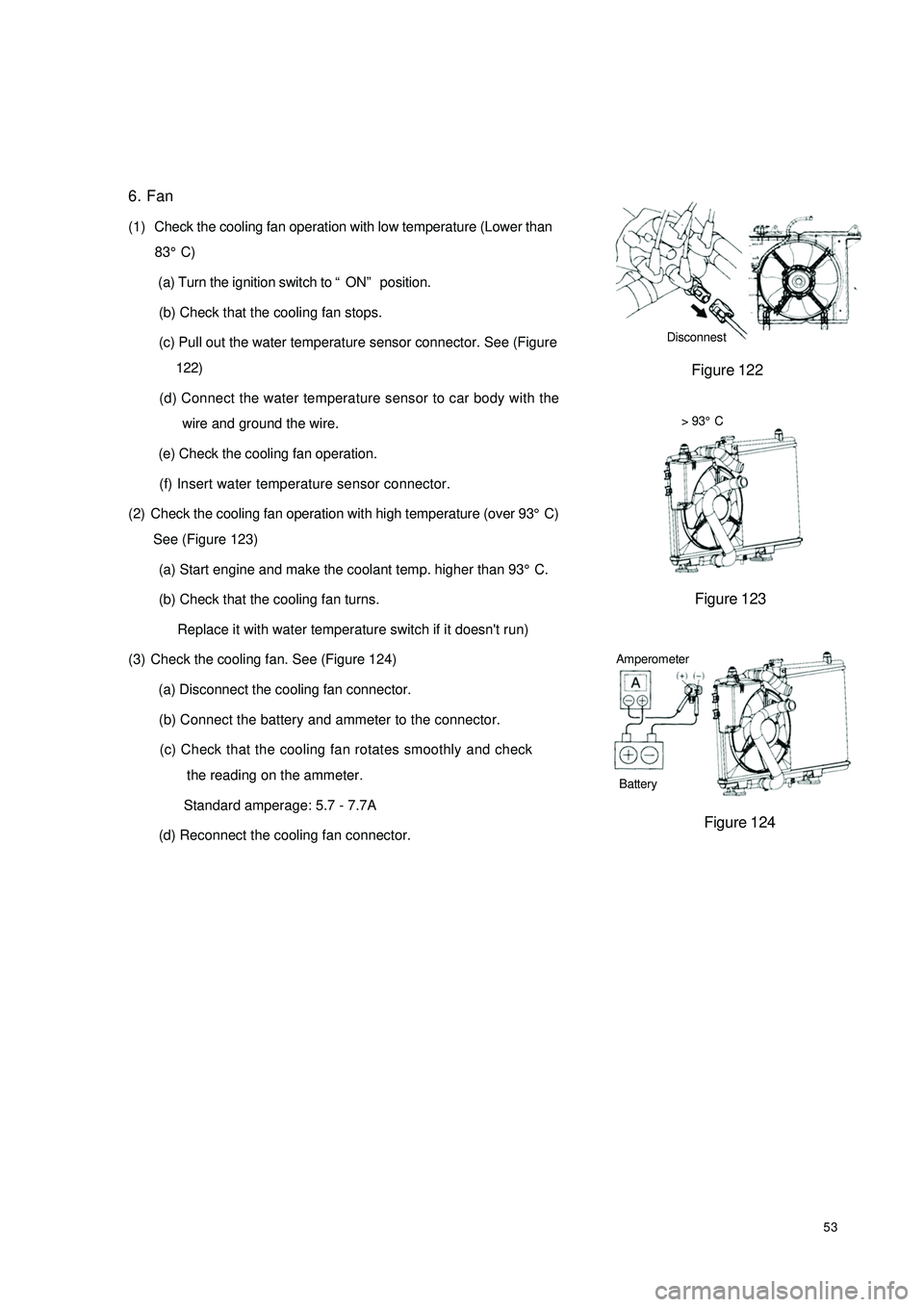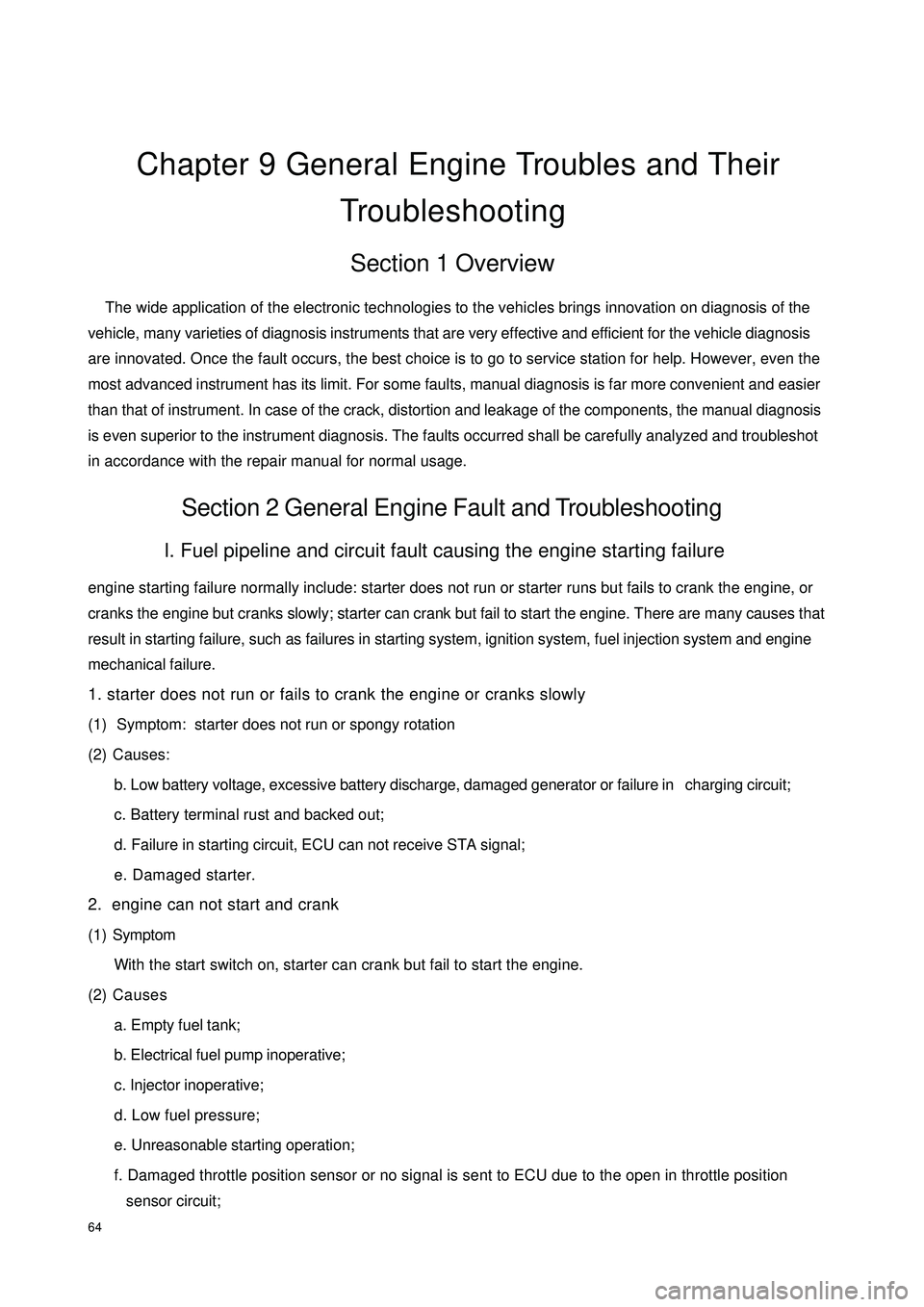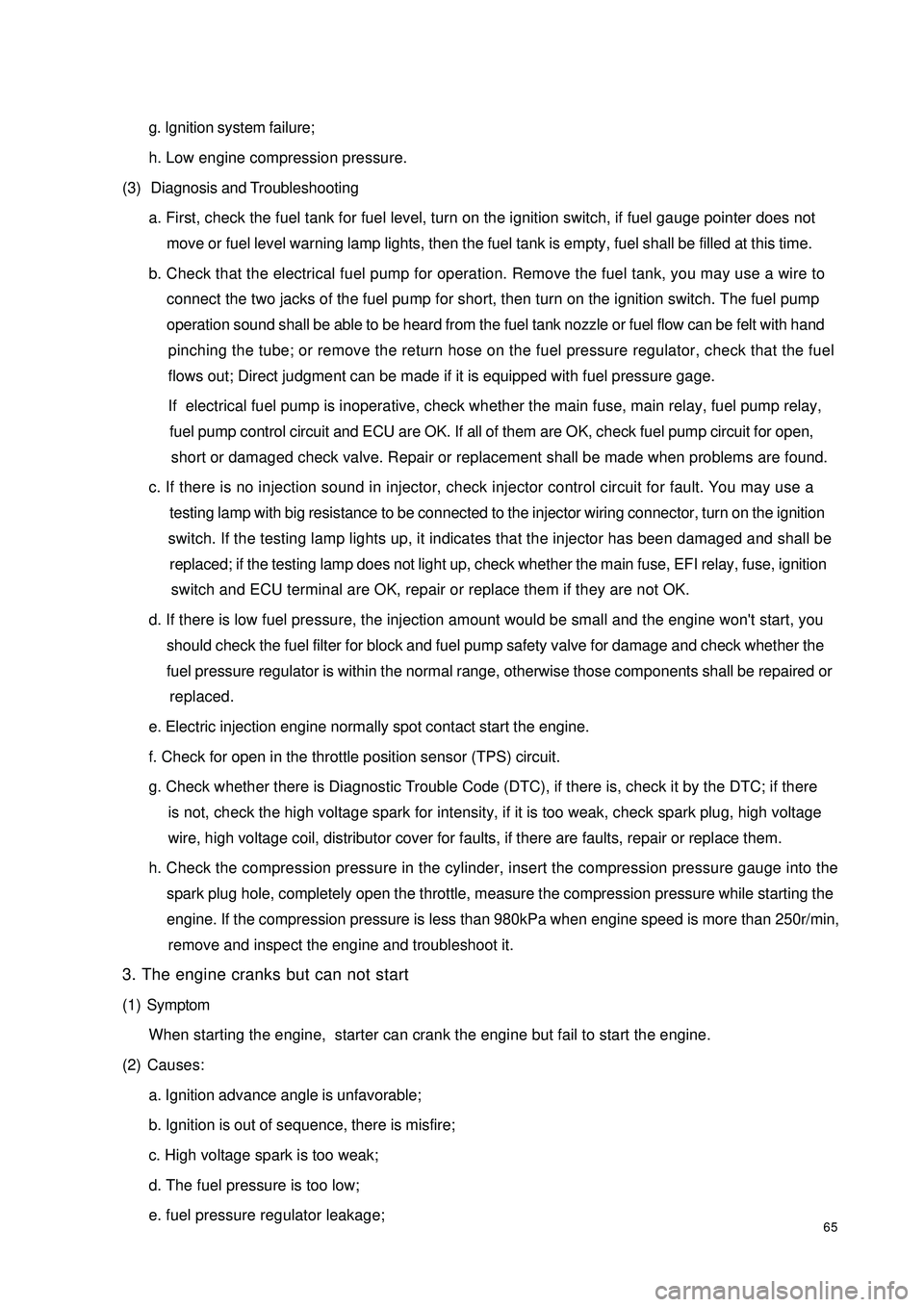2008 GEELY CK ignition
[x] Cancel search: ignitionPage 30 of 392

231. Disconnect all connected wire harnesses and the cable on the engine and the vehicle body
2. Remove air filter assembly with hose
3. Disconnect oil pipe and water hose
4. Loose positive and negative cables of the battery
5. Detach propeller shaft
6. Loose left & right rear engine mounting bracket after hoisting the engine.
7. Disconnect all other connectors between the engine and the vehicle body.
8. Remove engine per "Provison 20, Section 2, Chapter 2"
9. Remove A/C compressor to crankshaft pulleyV-belt
10. Remove power steering pump V- belt
11. Remove water pump fan pulley
12. Disconnect ignition coil and high voltage cables
13. Remove cylinder head cover sub-assembly
14. Remove generator assembly
15. Remove cylinder head cover sub-assembly
(a) Disconnect generator wire joint.
(b) Disconnect generator circuit
(c) Disconnect A/C compressor switch connector.
(e) Open wires clips.
(f) Disconnect wire harness from the cylinder head cover.
(g) Disconnect 2 ventilation PCV hoses from cylinder head cover.
(h) Remove 4 screws, 4 seal gaskets, cylinder head and gasket.
16. Remove generator assembly. See (Figure 50)
17. Remove timing belt cover
18. Remove crankshaft gear or pulley cover sub-assembly
19. Put the piston on Cylinder 1 to TDC compression position.
(a) Turn crankshaft pulley. Align its notch to the timing mark "O" on the
timing belt cover.
(b) Check if the mark "K" on camshaft timing pulley is aligned to the
timing mark on the bearing cap. Turn crankshaft 360° if not.
20. Remove ignition coil assembly
21. Remove timing belt. See (Figure 51)
(a) Mark on the timing belt and the camshaft pulley. The mark on the
timing belt to the timing belt cover No. 1 should match.
(b) Remove rubber gasket from timing belt cover.Figure 50
Figure 51
Page 34 of 392

2731. Install timing belt cover
Torque: 9.3N. m
32. Install generator assembly
33. Install right engine mounting bracket. See (Figure 67)
34. Install cylinder head cover sub-assembly
(a) Install 2 ventilation PCV hoses to the cylinder head cover.
(b) Connect the generator wire.
(c) Install the wire clip.
(d) Connect A/C compressor switch connector.
35. Install water pump pulley
36. Install power steering pump V-belt
37. Install A/C compressor to crankshaft pulleyV-belt
38. Install generator V-belt
39. Install left & right rear mounting bracket of engine.
40. Install ignition coil and high voltage cable
41. Hoist the engine back into the compartment
42. Install propeller shaft
43. Install air filter assembly with hose
44. Install oil pipe and water hoses
45. Install left and right front tires.
46. Check engine oil for leakage
47. Install all the wire harnesses and the cables on the engine connected to car bodyFigure 67
Page 38 of 392

31Replacement1. Disconnect all the wire harnesses and the cables on the engine connected to the car body.
2. Detach air filter assembly with hose
3. Disconnect oil pipe and water hose
4. Loose positive and negative cables of the battery.
5. Detach propeller shaft. Detach front exhaust pipe assembly
6. Loose engine left & right rear brackets after hoisting the engine.
7. Disconnect all the other connectors between the engine and the car body.
8. See "Provision 20, Section 2, Chapter 2". Lift the car body and take out the engine assembly.
9. Remove A/C compressor to the crankshaft pulleyV-belt.
10. Remove power steering pump V-belt.
11. Detach water pump fan pulley.
12. Disconnect ignition coil and high voltage cable.
13. Detach cylinder head cover sub-assembly.
14. Detach generator assembly.
15. Detach the camshaft.
16. Detach the throttle body assembly
17. Detach intake manifold stay No. 2.
18. Take out the dipstick
19. Detach No. 1 fuel delivery pipe
20. Detach the wire harness.
21. Detach the steering assisting pump assembly
22. Detach exhaust manifold. See (Figure 71)
23. Pry cylinder head from the dowel pin on the cylinder block.
See (Figure 72)
24. Remove the cylinder head gasket.
25. Install cylinder head gasket
26. Install cylinder head sub-assembly
27. Install exhaust pipe assembly.
(a) Install the new gasket and exhaust manifold with 5
bolts. Torque: 34N. m
(b) Install exhaust manifold stay with 2 bolts.
(c) Install upper heat shield with 4 bolts
Torque: 17N. mFigure 71
Figure 72
Page 39 of 392

3228. Install power steering adjusting pole
29. Install power steering pump assembly
30. Install wire harness.
31. Install No. 1 fuel delivery pipe
32. Set the new gasket on cylinder head with flange upward. Install water inlet hose. See
(Figure 73)
33. Install manifold stay No. 2
34. Connect front exhaust pipe assembly
35. Install throttle body assembly
36. Install camshaft
37. Install engine cylinder head cover
38. Hoist the engine back to the compartment.
39. Install engine right left and rear brackets
40. Install propeller shaft
41. Install ignition coil and high pressure cables. Install air filter assembly with hose
42. Install oil pipe and water hose
43. Install left & right front tire
44. Install all the wire harnesses and cables on the engine connected to car body
45. Check compression pressure
46. Check CO/HC. Check idle and ignition timingFigure 73
Page 48 of 392

41Chapter 4 Fuel System
(MR7131A, MR7151A, MR7161A)Section 1 Check Fuel System Pressure1. Remove the fuel tank from the vehicle
2. Check the fuel pump running
(a) Connect the positive and negative battery terminal to the concerned
fuel pump connector. See (Figure 91).
Notice: Do not start engine
The sound of fuel flowing can be heard if there is pressure.
Check fusible link, fuse, EFI open circuit relay, fuel pump, ECU and
wire connector if there is no pressure.
(b) Turn the ignition switch to "OFF" position.
3. Check fuel pressure
(a) Check battery electrical pressure to be above 12V.
(b) Detach negative terminal cable from the battery.
(c) Install pressure gage from the fuel delivery pipe. See (Figure 92).
(d) Connect battery negative terminal.
(e) Measure fuel pressure
Fuel pressure:
304-343kPa
Check fuel pipe & union, fuel pump, fuel filter if the pressure is too
low.
(f) Start engine. Measure fuel pressure at idle. Fuel pressure: 304-343kPa
(g) Check fuel pressure and retain the pressure for approximately 5min after the engine stopped.
Fuel pressure: 147kPaFigure 91Figure 92
Page 60 of 392

536. Fan
(1) Check the cooling fan operation with low temperature (Lower than
83°C)
(a) Turn the ignition switch to “ON” position.
(b) Check that the cooling fan stops.
(c) Pull out the water temperature sensor connector. See (Figure
122)
(d) Connect the water temperature sensor to car body with the
wire and ground the wire.
(e) Check the cooling fan operation.
(f) Insert water temperature sensor connector.> 93°C
See (Figure 123)
(a) Start engine and make the coolant temp. higher than 93°C.
(b) Check that the cooling fan turns.
Replace it with water temperature switch if it doesn't run)
(3) Check the cooling fan. See (Figure 124)
(a) Disconnect the cooling fan connector.
(b) Connect the battery and ammeter to the connector.
(c) Check that the cooling fan rotates smoothly and check
the reading on the ammeter.
Standard amperage: 5.7 - 7.7A
(d) Reconnect the cooling fan connector.Disconnest
Figure 123
Figure 124 Figure 122
(2) Check the cooling fan operation with high temperature (over 93°C)Battery Amperometer
Page 71 of 392

64Chapter 9 General Engine Troubles and Their
TroubleshootingSection 1 Overview The wide application of the electronic technologies to the vehicles brings innovation on diagnosis of the
vehicle, many varieties of diagnosis instruments that are very effective and efficient for the vehicle diagnosis
are innovated. Once the fault occurs, the best choice is to go to service station for help. However, even the
most advanced instrument has its limit. For some faults, manual diagnosis is far more convenient and easier
than that of instrument. In case of the crack, distortion and leakage of the components, the manual diagnosis
is even superior to the instrument diagnosis. The faults occurred shall be carefully analyzed and troubleshot
in accordance with the repair manual for normal usage.Section 2 General Engine Fault and TroubleshootingI. Fuel pipeline and circuit fault causing the engine starting failureengine starting failure normally include: starter does not run or starter runs but fails to crank the engine, or
cranks the engine but cranks slowly; starter can crank but fail to start the engine. There are many causes that
result in starting failure, such as failures in starting system, ignition system, fuel injection system and engine
mechanical failure.
1. starter does not run or fails to crank the engine or cranks slowly
(1) Symptom: starter does not run or spongy rotation
(2) Causes:
b. Low battery voltage, excessive battery discharge, damaged generator or failure in charging circuit;
c. Battery terminal rust and backed out;
d. Failure in starting circuit, ECU can not receive STA signal;
e. Damaged starter.
2. engine can not start and crank
(1) Symptom
With the start switch on, starter can crank but fail to start the engine.
(2) Causes
a. Empty fuel tank;
b. Electrical fuel pump inoperative;
c. Injector inoperative;
d. Low fuel pressure;
e. Unreasonable starting operation;
f. Damaged throttle position sensor or no signal is sent to ECU due to the open in throttle position
sensor circuit;
Page 72 of 392

65g. Ignition system failure;
h. Low engine compression pressure.
(3) Diagnosis and Troubleshooting
a. First, check the fuel tank for fuel level, turn on the ignition switch, if fuel gauge pointer does not
move or fuel level warning lamp lights, then the fuel tank is empty, fuel shall be filled at this time.
b. Check that the electrical fuel pump for operation. Remove the fuel tank, you may use a wire to
connect the two jacks of the fuel pump for short, then turn on the ignition switch. The fuel pump
operation sound shall be able to be heard from the fuel tank nozzle or fuel flow can be felt with hand
pinching the tube; or remove the return hose on the fuel pressure regulator, check that the fuel
flows out; Direct judgment can be made if it is equipped with fuel pressure gage.
If electrical fuel pump is inoperative, check whether the main fuse, main relay, fuel pump relay,
fuel pump control circuit and ECU are OK. If all of them are OK, check fuel pump circuit for open,
short or damaged check valve. Repair or replacement shall be made when problems are found.
c. If there is no injection sound in injector, check injector control circuit for fault. You may use a
testing lamp with big resistance to be connected to the injector wiring connector, turn on the ignition
switch. If the testing lamp lights up, it indicates that the injector has been damaged and shall be
replaced; if the testing lamp does not light up, check whether the main fuse, EFI relay, fuse, ignition
switch and ECU terminal are OK, repair or replace them if they are not OK.
d. If there is low fuel pressure, the injection amount would be small and the engine won't start, you
should check the fuel filter for block and fuel pump safety valve for damage and check whether the
fuel pressure regulator is within the normal range, otherwise those components shall be repaired or
replaced.
e. Electric injection engine normally spot contact start the engine.
f. Check for open in the throttle position sensor (TPS) circuit.
g. Check whether there is Diagnostic Trouble Code (DTC), if there is, check it by the DTC; if there
is not, check the high voltage spark for intensity, if it is too weak, check spark plug, high voltage
wire, high voltage coil, distributor cover for faults, if there are faults, repair or replace them.
h. Check the compression pressure in the cylinder, insert the compression pressure gauge into the
spark plug hole, completely open the throttle, measure the compression pressure while starting the
engine. If the compression pressure is less than 980kPa when engine speed is more than 250r/min,
remove and inspect the engine and troubleshoot it.
3. The engine cranks but can not start
(1) Symptom
When starting the engine, starter can crank the engine but fail to start the engine.
(2) Causes:
a. Ignition advance angle is unfavorable;
b. Ignition is out of sequence, there is misfire;
c. High voltage spark is too weak;
d. The fuel pressure is too low;
e. fuel pressure regulator leakage;